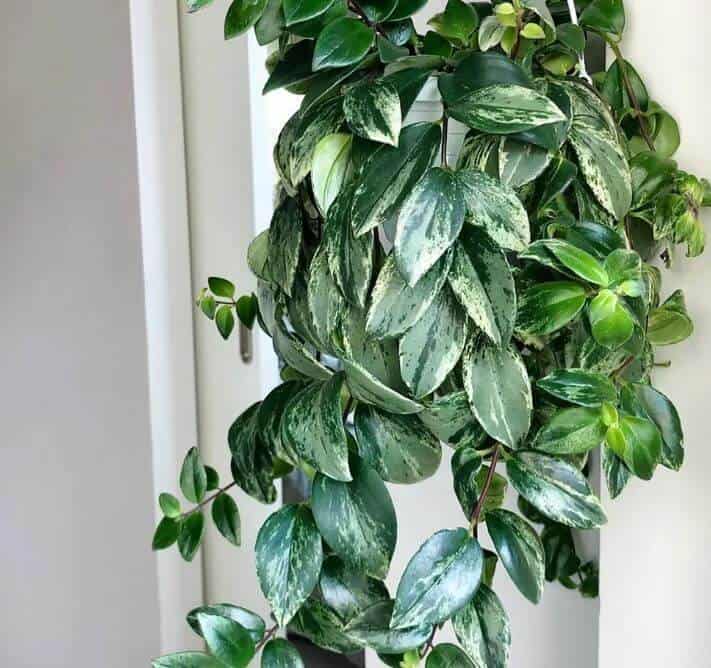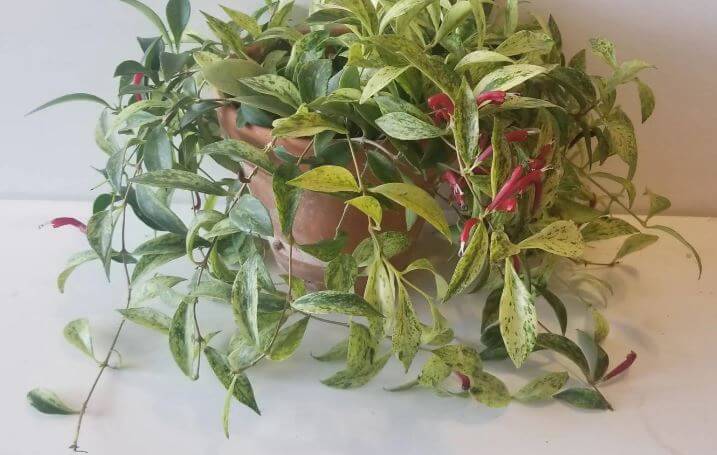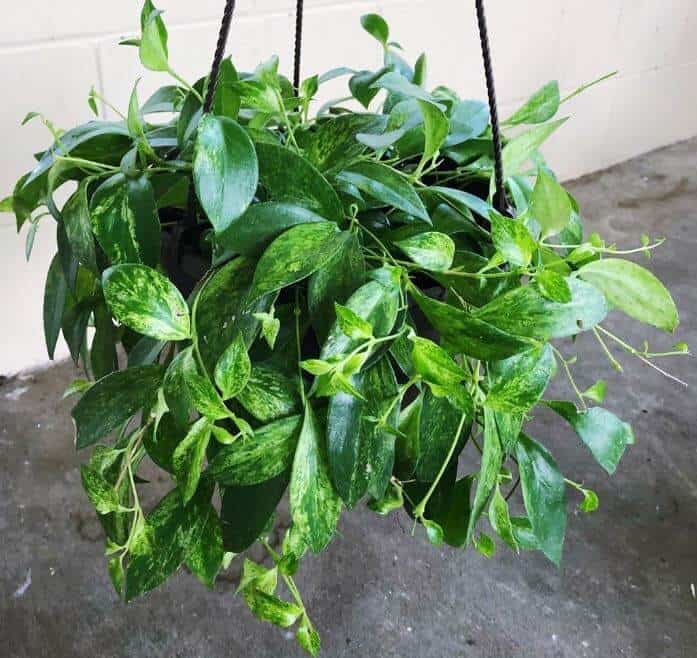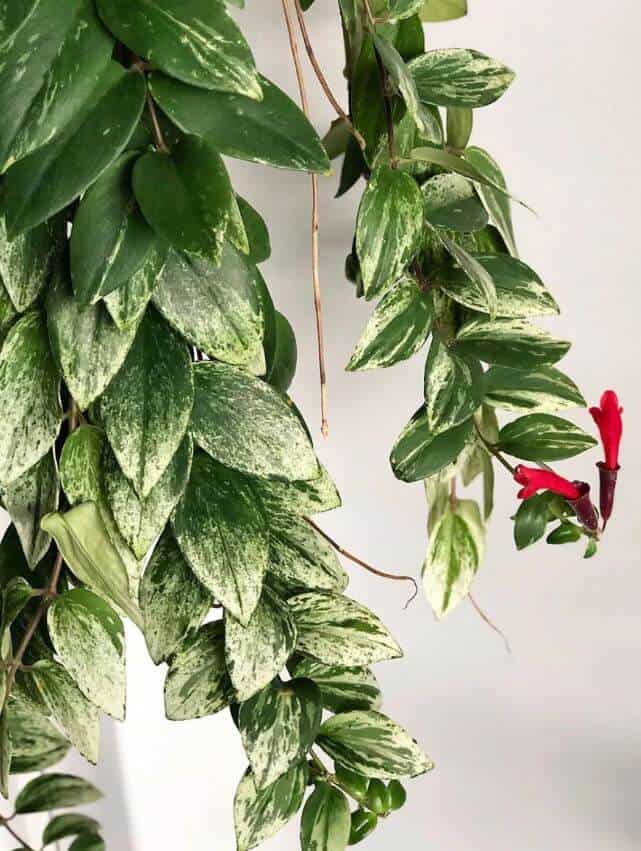Last Updated on January 6, 2023 by a Friendly Gardener
If you want to brighten up your indoor space, then nothing can beat the variegated lipstick plant (Aeschynanthus radicans ‘Variegata’).
This popular evergreen perennial flowering plant gets its name from the bright and vibrant reddish-orange-colored blooms that appear from a burgundy-colored bud that looks like a lipstick tube.
Native to the humid tropics of southeast Asia, the variegated lipstick plant has waxy, pointed green variegated leaves with streaks of cream, whites, and yellows mixed in.
In its native habitat, the variegated lipstick plant is an epiphytic species and you can find it growing in the cracks in rocks and from the branches of trees.
The glossy leaves of the lipstick plant variegated grow on trailing, vine-like stems. They cascade nicely, making them perfect for growing in tall containers or hanging baskets.
The variegated lipstick plant is a wonderful choice to add a bright pop of color to any room in your home, be it your kitchen, dining room, or bathroom.
Lipstick Plant Types
There are many types of lipstick plants including:
- Aeschynanthus micranthus ‘Variegata‘: The mini variegated lipstick plant has medium-sized green leaves with golden-yellow variegation and small reddish-colored blooms.
- Aeschynanthus radicans ‘Mona Lisa’: This variety has distinctive orangish-red-colored flowers.
- Aeschynanthus radicans ‘Curly’: The leaves of this variety of lipstick plants have a wavy appearance instead of smooth.
- Aeschynanthus radicans ‘Rasta’: The leaves of this variety are densely curled and the vivid red flowers bloom in late summer and early fall.
- Aeschynanthus radicans ‘Tangerine’: This variety bears yellowish-orange blooms.
Variegated Lipstick Plant Care

The variegated lipstick is very easy to grow and maintain. And, with proper care, you can get your lipstick plant to bloom continuously.
In their native habitat, these epiphytic plants get their moisture and nutrients from the air, but when grown as houseplants, as long as they get proper light and moisture, variegated lipstick plants thrive well in a regular potting mix.
In this section, we’ll discuss variegated lipstick plant care in detail.
Light
Variegated lipstick plants prefer bright light, but the light must be filtered. If they receive too much direct sunlight, it will cause the leaves to be scorched.
Too little light will cause the leaves to fall, and the plant will not produce lots of flowers. Avoid placing the plant in full sun or full shade.
Temperature and Humidity
The perfect temperature for your variegated lipstick plant is around 65°F-75°F. This will ensure that your plant is healthy and flowers well. Any fall in temperature below 50°F can cause the leaves to drop.
Since variegated lipstick plants are tropical, they prefer warmth and high humidity. So, to keep your plants healthy it is recommended to mist them regularly. Make sure to mist the plants in the morning to prevent fungal leaf spot disease.
The plant does not tolerate drafts and sudden temperature changes. So, avoid placing your variegated lipstick plant near the air conditioner, drafty windows, or doors.
Soil
The variegated lipstick plant grows well in a well-aerated, well-draining potting mix that is light and uniformly moist. You can add peat moss, perlite, or sand to the potting mix to promote aeration and drainage and prevent waterlogging.
Water

The variegated lipstick plant needs consistent moisture, especially during the growing period. But overwatering can cause root rot, fungal problems, and leaf drop.
The plant does well with moderate watering. Ideally, water the plant when the top one to two inches is not damp, but make sure that potting mix does not dry out completely.
Fertilizing
The variegated lipstick plant does well with the regular application of fertilizer, around one to two times a month. It is recommended to use a slow-release fertilizer during the plant’s growing season.
Pests and Diseases
Generally, the variegated lipstick plant is not susceptible to pests, but you can face problems with pests such as mealybugs, mites, and aphids. You can wash the pests off using a water spray or treat the plant with horticultural oils to get rid of the pests.
If the plants get too wet, they can be prone to root rot, leaf spot, and other fungal diseases. Make sure that the potting mix is well-drained and prevents the leaves from getting damp.
Propagation
Variegated lipstick plants can be propagated easily from soft stem cuttings but you can grow these plants from seeds too.
Pruning
Since the variegated lipstick plant tends to cascade, it can become straggly and unkempt. Pruning not only helps to give the plant a neater and fuller appearance but also promotes healthy growth.
Getting Your Variegated Lipstick Plant to Bloom

To ensure that your variegated lipstick plant blooms continuously, it is important to meet the basic requirements, including:
- Lots of bright but indirect sunlight. Avoid direct sunlight.
- Consistent warm temperature and a humid environment.
- An appropriate amount of water.
- Regular fertilization with diluted fertilizer.
Tips for Growing Healthy Variegated Lipstick Plants

Here are some tips that can help to ensure the good and healthy growth of your variegated lipstick plant:
- Use a hanging basket or container to plant the cascading variegated lipstick plant. You can also grow the plant on wooden slabs, but you must ensure that the plant is kept adequately moist.
- If you’re growing the variegated lipstick plant from cuttings, then make sure that the plant gets proper light. The optimal temperature for flowering is 70°F.
- Since the variegated lipstick plant is native to the tropics, it thrives in high-humidity conditions.
- If the leaves of the plant turn yellow or they start falling, it means that probably, the plant needs more light, water or both.
- If the leaves or the edges of the leaves turn brown, then it may mean that the plant is getting too much sunlight or too less water.
Wrapping Up
Variegated lipstick plants with their tubular vibrant orange-red “lipstick-like” blooms make fantastic houseplants.
Plant them in a container and place them in any brightly lit room to add a dash of color or in a hanging basket to brighten up your balcony. With a little bit of maintenance and care, these easy-to-grow plants can be a great addition to your home.

